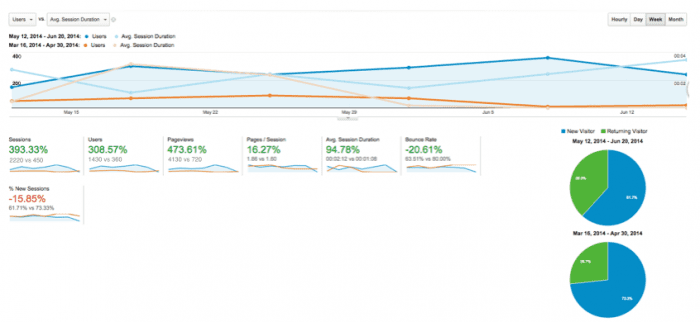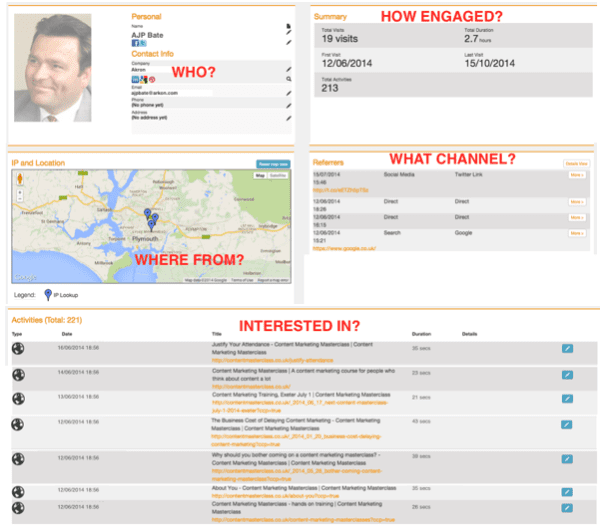How I boosted my lead generation with visitor tracking software, in conjunction with blogging, pay per click, email and social media outreach.
When you’re growing an audience, and converting website visitors into customers, you need a watertight marketing funnel.
The sad truth is that most of us convert less than 5 per cent of our website visitors into contacts, meaning that more than 95% of visitors leave our sites, potentially never to be seen again.
So what steps can we take to improve our website marketing, tighten up our funnel, and generate more leads from what we have already?
I faced this challenge earlier this year, and have written this post to share my experience with you.
My website was only four months old, so I had insufficient visitor data in Analytics, and I was up against a tight deadline. My challenge was that I needed to generate more leads, more quickly from my website, and boost participation at a paid event I was running just 6 weeks later. I was already doing a mixture of outbound and inbound marketing, including Pay Per Click (PPC), Blogging, email and social media marketing.
Here is what I had to work with:
- 450 email contacts (MailChimp)
- 870 connections (LinkedIn)
- 900 followers (Twitter)
- 360 website users / week
- 20% engagement or 80% bounce
- 2 blog posts per week
- PPC Google campaign
- Event landing page on Eventbrite
I needed my blogging output, email and social media outreach to boost traffic to my website and improve my top line visitor engagement metrics: Page views, session duration, and page depth. The results were favourable, as evidenced in Figure 1.

Blue lines show performance uplift during inbound / outbound marketing programme
I was able to monitor and measure the efficacy of my posts, tweets and emails in Google Analytics, MailChimp and SocialShare, but I also wanted to identify my warmest prospects and see their engagement and interest, once they arrived on my website.
I wanted to be notified of their return in real time, so that I could reach out to them at the most opportune time, when they were more receptive to a call from me.
Timing was the key and I wanted to contact prospects within just minutes of them visiting my website, or better still whilst they were on my website. This is where online and offline complement one another, as long as the timing is right. The success factor is "Relevance", a the one marketing quality I keep coming back to, time and again.
The solution I wanted, needed to help me do the following:
1. Understand as much as possible about returning visitors
Who is returning to my website? What channels are they coming from? What geographic location? What organisation and sector? What pages and activities are they completing? How long are they dwelling? What is their visitor flow?
2. Understand their interests
What are they most interested in? What can I deduce from the content they’re consuming? What have they missed in their journey through my website?
3. Who are my warmest prospects?
Who can I contact based on return rates, time on site, activities, page depth, visitor profile? What insight can I use to justify my call to them?
4. Who is it safe to call?
Which visitors can I call or email using the insights I have about their organisation and interests? Who might need answers to questions that they cannot get on the website? How can I personalise my call based on my experience with similar clients and relevant case studies?
After some research I chose Canddi visitor tracking, partly for its affordable price, but also because the client support team was so helpful and friendly, in helping me set the code and monitoring dashboard up.
As soon as I began using Canddi in conjunction with my blogging activity, PPC, and outreach I became acutely aware of the benefits of visitor tracking when used properly:
- Suddenly I was able to track the behaviour of my email subscribers beyond open and click through, and see what they were doing when they landed on my website.
- I could see, research (via LinkedIn) and focus on my warmest prospects, and reach out to them first, in a timely fashion, when they were most receptive to a conversation.
- It removed fears I had of rejection, now that I was confident in the knowledge they were interested in the event I was running.
- I was able to move more visitors into my prospect funnel and convince more of them that the event was right for them.
Here is an example of the sorts insights I was getting:

The software provided me with an update on returning visitors in my stream and prompted me to seek them out. After a few days I added a “help” capsule that popped up in front of browsing visitor after they completed their third visit. This prompted the visitor to ask a question they were otherwise unable to find an answer to on the website. This was helpful when I was not on my screen, since it ensured the visitor was prompted to move a step closer to identifying themselves.
Post scriptum: Canddi have since introduced a new benefit: Users can now add Canddi tracking into every outbound email they send from their regular email host (e.g. Gmail), using a simple Chrome extension, which sends a notification popup each time a recipient opens an email and clicks on a link within it. This is like Signals, the Hubspot version of the same.
Thanks for reading. What’s your experience of using software for tracking visitors on your website, and what user tips do you have to improve website lead generation?
Main photograph: Pavel Horak - Flickr








